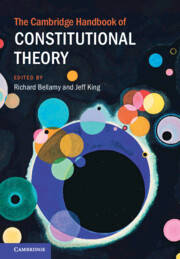Book contents
- The Cambridge Handbook of Constitutional Theory
- The Cambridge Handbook of Constitutional Theory
- Copyright page
- Contents
- Figures
- Contributors
- Frontispiece
- Preface and Acknowledgements
- 1 Introduction
- Part I Values
- Part II Modalities
- Part III Institutions
- Part III. A The State
- Part III. B The Executive
- Part III. C The Democratic System
- Part III D The Legal System
- 48 Constitutional Courts and Supreme Courts
- 49 Judicial Independence
- 50 Bills of Rights
- 51 Administrative Law
- 52 Horizontal Effect
- Part III E The Global System
- Part IV Challenges for Constitutional Democracy
- Bibliography
- Index
- References
48 - Constitutional Courts and Supreme Courts
from Part III D - The Legal System
Published online by Cambridge University Press: 27 March 2025
- The Cambridge Handbook of Constitutional Theory
- The Cambridge Handbook of Constitutional Theory
- Copyright page
- Contents
- Figures
- Contributors
- Frontispiece
- Preface and Acknowledgements
- 1 Introduction
- Part I Values
- Part II Modalities
- Part III Institutions
- Part III. A The State
- Part III. B The Executive
- Part III. C The Democratic System
- Part III D The Legal System
- 48 Constitutional Courts and Supreme Courts
- 49 Judicial Independence
- 50 Bills of Rights
- 51 Administrative Law
- 52 Horizontal Effect
- Part III E The Global System
- Part IV Challenges for Constitutional Democracy
- Bibliography
- Index
- References
Summary
There are two practices of constitutional review: the diffuse review by the judiciary with supreme courts as the final appellate body in common law countries and the concentrated review by constitutional courts outside the ordinary judiciary in civil law countries. Though we observe a tendency towards a convergence of diffuse and concentrated review, there are still differences. In this chapter, the comparative merits and problems of concentrated versus diffuse review are evaluated. In order to compare the types of apex courts, a normative concept of constitutional review is developed. According to this concept, the most important precondition for legitimate and effective constitutional review is the difference between judicial and political decision-making. Judges who are capable of respecting this difference, enhance social integration by establishing a specific mechanism to correct procedural and substantive injustices. When evaluated by this standard, neither supreme nor constitutional courts are superior. Rather, the problem of both practices concerns a gradual process of a judicialization of politics. More and more political questions are decided by apex courts with constitutional review power, thereby reducing political alternatives. In concluding, a division of labor between judges and legislators is suggested that promises legitimate and effective constitutional review enriching democratic governance.
Keywords
- Type
- Chapter
- Information
- The Cambridge Handbook of Constitutional Theory , pp. 848 - 866Publisher: Cambridge University PressPrint publication year: 2025

